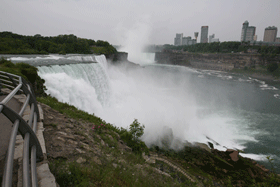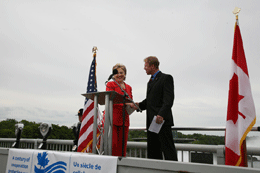Another Century of Great Lakes
Air Date: Week of July 3, 2009

The Boundary waters treaty centennial was held at Niagra falls. (Photo: Dave Miller / International Joint Commission)
America and Canada have shared the benefits and responsibilities of the Great Lakes for a century. Now the international agreement that keeps both sides in check is getting an update. Dr. John Gannon is a senior scientist at the International Joint Commission. He tells host Jeff Young what the new agreement might look like for the next 100 years.
Transcript
YOUNG: The U.S. and Canada just marked a century of cooperative conservation: the hundredth anniversary of the Boundary Waters Treaty. The treaty guides management of the Great Lakes, which contain one-fifth of the world's fresh surface water. And the anniversary comes just as that treaty is being re-negotiated to better respond to new challenges like climate change and invasive species.
Dr. John Gannon is senior scientist for the International Joint Commission that advises both countries on the Lakes. Gannon says the Boundary Waters Treaty was the world’s first environmental agreement between two nations. And it came at a time when environmental issues were nearly unheard of.
GANNON: Back in 1900 it was kind of the peak of cholera and typhoid fever epidemics. Folks thought that the Great Lakes were so large they couldn’t be polluted so the intakes for drinking water were very close to the untreated sewage outfalls, so that was a huge problem in 1900. And at the same time, hydropower was starting to be developed on the Niagara River and so there were some conflicts between, of course, Great Britain on behalf of the dominion of Canada and the United States at times. So both water quantity and water quality issues were in conflict at that time that spurred the negotiations for the Boundary Waters Treaty.
YOUNG: Interesting. So it was initially driven primarily by public health aspects of dealing with sewage and also this hydropower thing. How have the concerns evolved over time?

Secretary of State Hillary Clinton announced the United States will update treaty. (Photo: Dave Miller / International Joint Commission)
YOUNG: Now there are a lot of thirsty states in the arid regions of the country who look up at all that yummy fresh water in the Great Lakes and say “hey, if we had a long enough straw, we could get some of that.” What’s the status of that kind of thinking? Has that been nipped in the bud or are there still projects afoot that might draw down water from the Great Lakes and export it?

The Boundary waters treaty centennial was held at Niagra falls. (Photo: Dave Miller / International Joint Commission)
YOUNG: Now you’ve been working on this for quite a while now. Compare say the Lake Erie you saw in the 60s to the lake you see today.
GANNON: Oh, it’s better. There’s no question about that. What I like to tell the public is we’ve got kinda of this mix of positive and negative things going on all at once. So back then the lake sturgeon was almost completely gone. The walleye population was extremely depressed. Bald eagles weren’t reproducing. And so today we’ve got recovery of lake sturgeon. Lake whitefish are making a comeback. The walleye population is in much better shape than it was back then. Bald eagles are nesting on the shoreline throughout the lake so we’ve got a lot of these very, very positive things that are going on. But then yet the zebra mussel came in and we’ve got lots more upsets in the system going on. And actually, I’ve worked on the Great Lakes since 1966, when I was a graduate student and I never thought I’d ever see in my lifetime some of these bad algae and weed problems that we saw in the 60s come back in Lake Erie today. So, we can’t let our guard down and that’s the importance I think of the Great Lakes Water Quality Agreement and this recent announcement that the governments are updating it.
YOUNG: Dr. John Gannon is senior scientist at the International Joint Commission working to make sure that the Great Lakes stay that way – great. Thanks very much for your time.
GANNON: Thank you.
[MUSIC: Brian Henke “Great Lakes” from So Many Waters (VisionQuest Records 1997)]
CURWOOD: Just ahead: the tale of some unsung heroes of the environmental movement – the Coast Guard Service. Stay with us on Living on Earth.
Links
Learn more about The Boundary Waters Treaty.
Click here for more on the international Great Lakes water quality agreement.
Living on Earth wants to hear from you!
Living on Earth
62 Calef Highway, Suite 212
Lee, NH 03861
Telephone: 617-287-4121
E-mail: comments@loe.org
Newsletter [Click here]
Donate to Living on Earth!
Living on Earth is an independent media program and relies entirely on contributions from listeners and institutions supporting public service. Please donate now to preserve an independent environmental voice.
NewsletterLiving on Earth offers a weekly delivery of the show's rundown to your mailbox. Sign up for our newsletter today!
 Sailors For The Sea: Be the change you want to sea.
Sailors For The Sea: Be the change you want to sea.
 The Grantham Foundation for the Protection of the Environment: Committed to protecting and improving the health of the global environment.
The Grantham Foundation for the Protection of the Environment: Committed to protecting and improving the health of the global environment.
 Contribute to Living on Earth and receive, as our gift to you, an archival print of one of Mark Seth Lender's extraordinary wildlife photographs. Follow the link to see Mark's current collection of photographs.
Contribute to Living on Earth and receive, as our gift to you, an archival print of one of Mark Seth Lender's extraordinary wildlife photographs. Follow the link to see Mark's current collection of photographs.
 Buy a signed copy of Mark Seth Lender's book Smeagull the Seagull & support Living on Earth
Buy a signed copy of Mark Seth Lender's book Smeagull the Seagull & support Living on Earth

